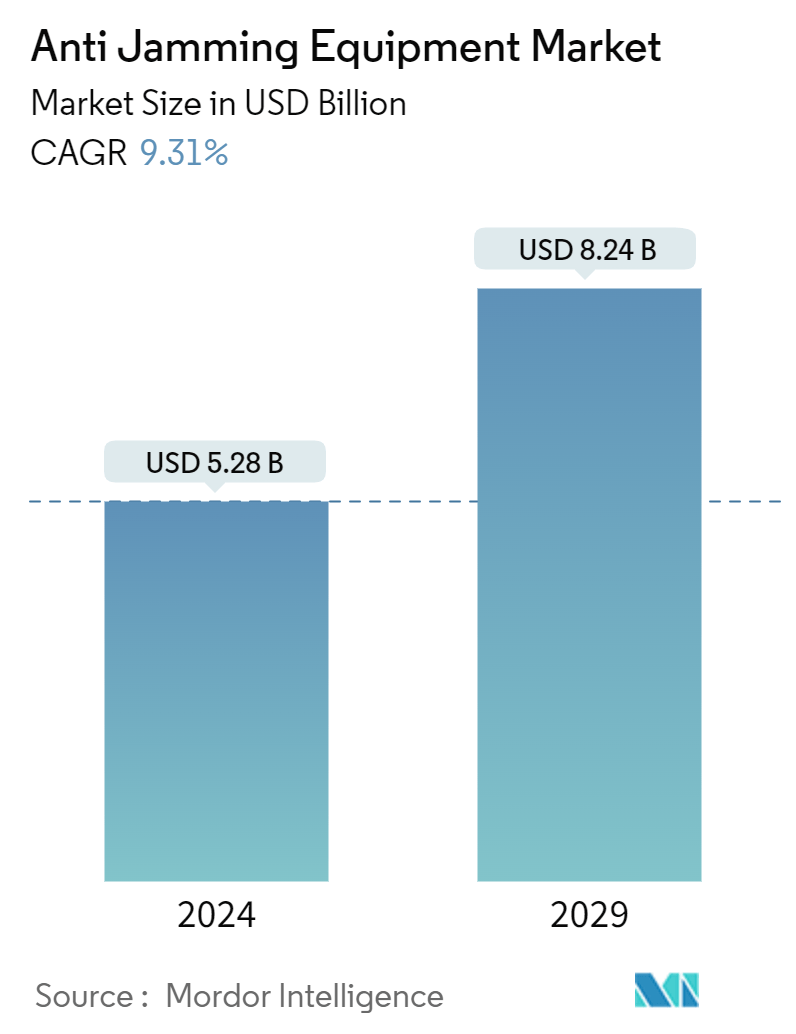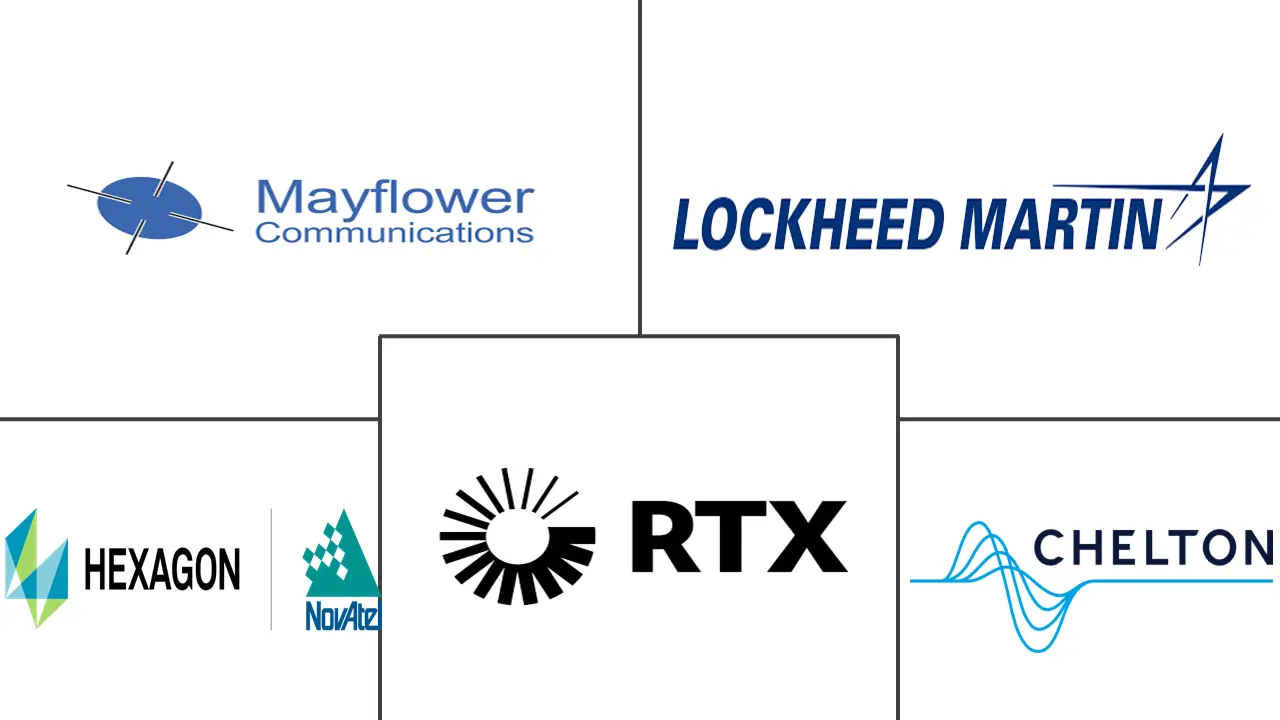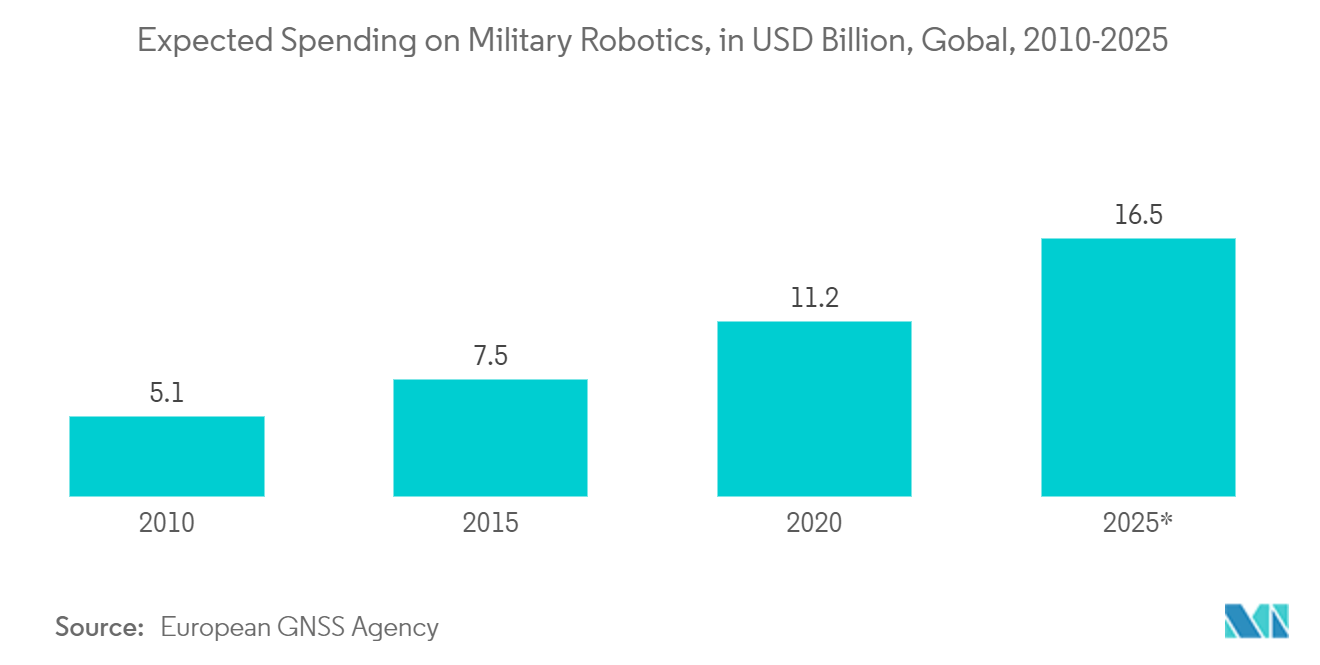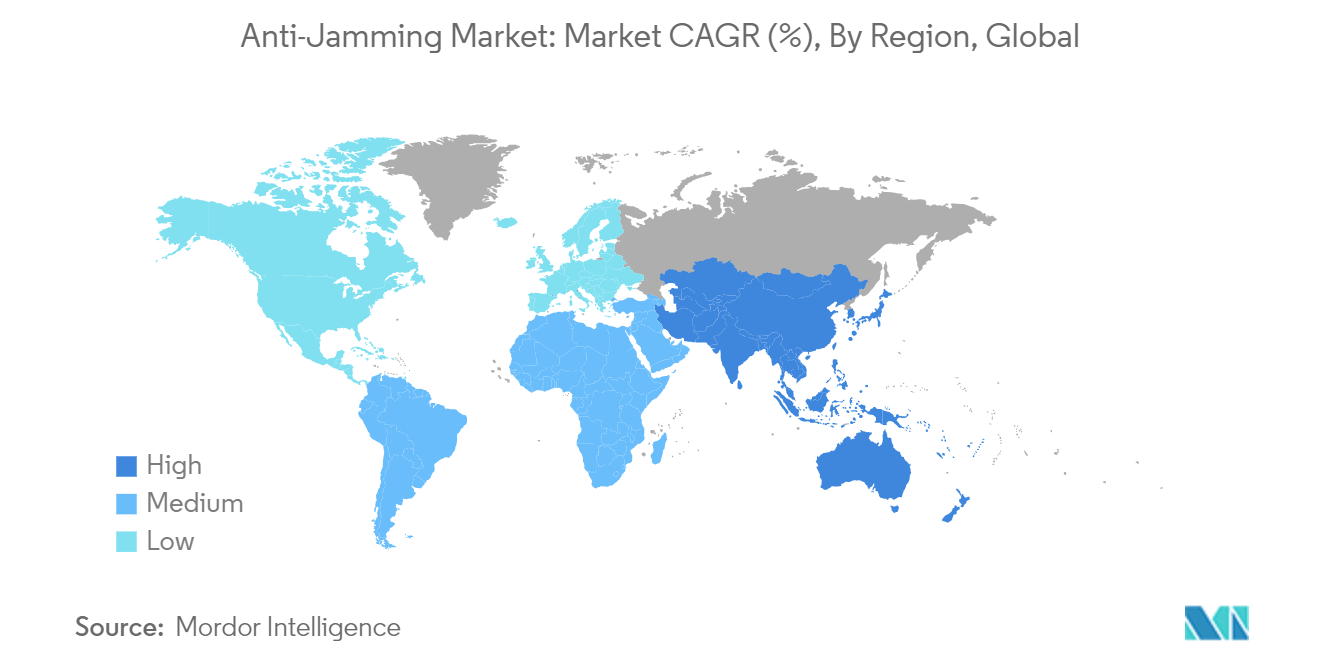Anti-Jamming Equipment Market Size

| Study Period | 2019 - 2029 |
| Market Size (2024) | USD 5.28 Billion |
| Market Size (2029) | USD 8.24 Billion |
| CAGR (2024 - 2029) | 9.31 % |
| Fastest Growing Market | Asia Pacific |
| Largest Market | North America |
Major Players
*Disclaimer: Major Players sorted in no particular order |
Anti-Jamming Equipment Market Analysis
The Anti Jamming Equipment Market size is estimated at USD 5.28 billion in 2024, and is expected to reach USD 8.24 billion by 2029, growing at a CAGR of 9.31% during the forecast period (2024-2029).
Anti-jamming solutions are essential across a range of applications. Unmanned vehicles, automated robotic platforms, time synchronization systems, and various military vehicles face threats due to the challenges in receiving GNSS signals. The swift evolution of jammers, compounded by industrial noise, has heightened the demand for interference immunity to ensure reliable operations. This increased demand has led to significant advancements in anti-jamming technologies, which are now more sophisticated and effective than ever.
- Jamming can disrupt wireless transmissions, leading to denial of service (DOS), insertion of unwanted messages, original content corruption, and blocking critical messages, all while interfering with radio signals. The impact of jamming on communication systems can be severe, causing significant operational disruptions and potential security breaches. Therefore, developing and deploying robust anti-jamming solutions are crucial for maintaining the integrity and reliability of wireless communication networks.
- GPS technology is developing, focusing on miniaturization, weight reduction, and heightened accuracy. GPS satellites act as precise timekeepers, relaying both time and orbital data. A receiver pinpoints its Earth location by analyzing signals from at least three satellites.
- The increasing deployment of General Packet Radio Services (GPRS) infrastructure drives the demand for anti-jamming equipment, particularly in sectors reliant on secure and reliable communications. GPRS enhances data transfer capabilities for mobile networks, facilitating machine-to-machine (M2M) communication, IoT devices, and mobile internet access. As more devices connect, the potential for interference and jamming increases, particularly in critical applications like defense, transportation, and emergency services.
- The demand for fully autonomous drones is rising across industries, from agriculture and construction to search and rescue operations. These systems rely on continuous communication with GPS and ground stations. Jamming could cause a loss of control, making anti-jamming technology vital for safety and operational success. Further, the market is expected to benefit from the increased demand for unmanned airborne vehicles and systems and the development of low-cost GPS anti-jamming solutions during the forecast period.
- The complexity of manufacturing anti-jamming equipment poses several challenges that can restrain the market's growth. This complexity arises from the need to meet high performance, cost-effectiveness, and adaptability standards, especially in military, defense, and commercial applications.
Anti Jamming Equipment Market Trends
Defense Holds Major Share
- The growth of GPS technology in military applications is driven by the need for precision, real-time situational awareness, secure communication, the increasing use of autonomous systems, and the constant threat of electronic warfare. As military technology evolves, GPS remains a critical enabler of modern defense operations, fueling further demand for advanced GPS systems.
- Ongoing conflicts have increased the demand for anti-jamming systems due to the growing use of unmanned systems for casualty evacuations. These systems are crucial for military operations, making it essential to protect them from interference. Anti-jamming technologies mitigate jamming risks, ensuring the reliability of unmanned systems in casualty evacuations.
- Substantial growth opportunities arise from the high demand for durability and resistance to enemy technology in military applications. This demand primarily focuses on unmanned aerial vehicles (UAVs) for surveillance, reconnaissance, and combat operations. Additionally, there is a need for munitions, guided systems, and cost-effective GPS anti-jamming solutions.
- The use of autonomous military systems like drones, unmanned ground vehicles, and robotic systems is increasing. These systems depend heavily on GPS for navigation and mission execution. In contested environments, jamming or spoofing GPS signals could disable or mislead these systems. Anti-jamming equipment protects these autonomous platforms and ensures their operational effectiveness. According to IFR, spending on military robotics is anticipated to rise by USD 16.5 billion by 2025.
- Many countries are modernizing their military forces and integrating advanced GPS technologies for better operational capabilities. As part of these modernization programs, governments invest heavily in anti-jamming solutions to protect GPS-reliant systems such as missile guidance systems, command and control (C2) infrastructure, surveillance, and intelligence-gathering platforms. This increasing investment is driving the growth of the anti-jamming market in the defense sector.

Asia Pacific to Register Major Growth
- China's swift economic growth and integration into the global landscape have deepened its reliance on dependable navigation and communication systems. The transportation and logistics sectors, heavily dependent on GPS and satellite-based navigation, utilize these technologies for route optimization, cargo tracking, and ensuring the smooth transit of goods and individuals. Thus, both public and private sectors are prioritizing investments in anti-jamming solutions.
- In February 2024, Chinese scientists unveiled electronic warfare (EW) equipment capable of swiftly detecting, decoding, and neutralizing enemy signals. It empowers the People’s Liberation Army (PLA) to effortlessly monitor signals within the gigahertz range, including frequencies utilized by amateur radio. Moreover, the equipment boasts signal processing chips and AI integration, bolstering China's capacity to counteract jamming and ensure uninterrupted communication.
- The increase in the defense budget has prompted the government to enhance its defense capabilities and to implement additional anti-jamming technology to bolster national security. In addition to defense advancements, Japan's aviation sector is experiencing notable expansion. This industry necessitates the development of potential jammers to disrupt the GNSS signals of aircraft, which is becoming essential for navigation, targeting, and reconnaissance operations where dependability is crucial.
- The anti-jamming equipment market presents significant growth opportunities, driven by heightened investments in research and development and an increasing demand for anti-jamming solutions across diverse sectors. For instance, in December 2023, Israel Aerospace Industries (IAI) signed a contract with Korea Aerospace Industries (KAI) to provide its ADA system for the Light Armed Helicopter (LAH) program. As part of this agreement, IAI will provide its ADA system, a GPS Anti-Jamming solution designed to mitigate interference from multiple jammers from various directions.

Anti-Jamming Equipment Industry Overview
The market is dominated by major players like RTX Corporation, Chelton Limited, L3Harris Technologies Inc., BAE Systems PLC, etc., that offer superior technology and foster their growth through their existing distribution channels. These technology leaders are investing in product innovation and mergers and acquisition activities to maintain a competitive edge in the market.
Few major vendors command a significant market share, and effective government regulations associated with the technology have led to the moderate consolidation of the anti-jamming equipment market in the last few years.
However, the emergence of start-ups and new players in the market and growing government interest in commercial solutions, combined with increasing investments in new players, has increased the competition in the market.
Anti Jamming Equipment Market Leaders
-
RTX Corporation
-
Chelton Limited
-
Novatel Inc. (Hexagon AB)
-
Mayflower Communications
-
Lockheed Martin Corporation
*Disclaimer: Major Players sorted in no particular order

Anti-Jamming Equipment Market News
- September 2024: Lockheed Martin and Tata Advanced Systems Limited solidified their partnership with a partnership agreement centered on the C-130J Super Hercules tactical airlift. This move would bolster India’s defense and aerospace and strengthen the strategic bond between India and the United States.
- April 2024: Raytheon, a leading US defense contractor and a subsidiary of RTX, planned to enhance its 'Controlled, Advanced, Distributed Radio Frequency Effects' (CADRE) system for seamless integration with the US Navy's Next Generation Jammer.
Anti Jamming Equipment Market Report - Table of Contents
1. INTRODUCTION
- 1.1 Study Assumptions and Market Definition
- 1.2 Scope of the Study
2. RESEARCH METHODOLOGY
3. EXECUTIVE SUMMARY
4. MARKET INSIGHTS
- 4.1 Market Overview
-
4.2 Industry Attractiveness - Porter's Five Forces Analysis
- 4.2.1 Bargaining Power of Suppliers
- 4.2.2 Bargaining Power of Buyers
- 4.2.3 Threat of New Entrants
- 4.2.4 Threat of Substitutes
- 4.2.5 Intensity of Competitive Rivalry
- 4.3 Industry Value Chain Analysis
- 4.4 Assessment of the Impact of Macroeconomic Factors on the Market
5. MARKET DYNAMICS
-
5.1 Market Drivers
- 5.1.1 Increased Demand for GPS Technology in Military Applications
- 5.1.2 Improving Overall GPRS Infrastructure
- 5.1.3 Rising Demand for Unmanned Airborne Vehicles and Systems
-
5.2 Market Restraints
- 5.2.1 Complexity in Manufacturing
- 5.2.2 Interoperability with Existing Systems
6. MARKET SEGMENTATION
-
6.1 Technology
- 6.1.1 Nulling Technique
- 6.1.2 Civilian Techniques
- 6.1.3 Beam Steering Techniques
-
6.2 End-user Application
- 6.2.1 Flight Control
- 6.2.2 Defense
- 6.2.3 Surveillance and Reconnaissance
- 6.2.4 Navigation, Position, and Timing
- 6.2.5 Casualty Evacuation
- 6.2.6 Other End-user Applications
-
6.3 Geography***
- 6.3.1 North America
- 6.3.1.1 United States
- 6.3.1.2 Canada
- 6.3.2 Europe
- 6.3.2.1 Germany
- 6.3.2.2 United Kingdom
- 6.3.2.3 France
- 6.3.3 Asia
- 6.3.3.1 China
- 6.3.3.2 Japan
- 6.3.3.3 South Korea
- 6.3.4 Australia and New Zealand
- 6.3.5 Latin America
- 6.3.6 Middle East and Africa
7. COMPETITIVE LANDSCAPE
-
7.1 Company Profiles
- 7.1.1 RTX Corporation
- 7.1.2 Chelton Limited
- 7.1.3 Novatel Inc. (Hexagon AB)
- 7.1.4 Mayflower Communications
- 7.1.5 Lockheed Martin Corporation
- 7.1.6 Safran
- 7.1.7 L3Harris Technologies Inc.
- 7.1.8 BAE Systems PLC
- 7.1.9 Israel Aerospace Industries Ltd
- 7.1.10 Thales Group
- 7.1.11 Forsberg Services Ltd
- 7.1.12 Tualcom
- 7.1.13 Septentrio NV
- *List Not Exhaustive
8. INVESTMENT ANALYSIS
9. FUTURE OF THE MARKET
** Subject To AvailablityAnti-Jamming Equipment Industry Segmentation
Anti-jamming equipment protects signal receivers from intervention and deliberate jamming. For instance, when a GPS signal reaches the earth's surface, it becomes weak and susceptive to being overcome by more powerful radio frequency (RF) energy. GPS anti-jamming handles power minimization to decrease the effect of interference and jamming so that the GPS receiver can continue to function correctly. The market's scope is limited to anti-jamming equipment offered by market vendors, which includes civilian and defense applications.
The anti-jamming equipment market is segmented by technology (nulling technique, civilian techniques, and beam steering techniques), end-user application (flight control, defense, surveillance and reconnaissance, navigation, position, timing, casualty evacuation, and other end-user applications), and geography (North America (United States, Canada), Europe (Germany, United Kingdom, France, rest of Europe), Asia-Pacific (China, Japan, South Korea, rest of Asia-Pacific) and rest of the World). The report offers market forecasts and size in value (USD) for all the above segments.
| Technology | Nulling Technique | |
| Civilian Techniques | ||
| Beam Steering Techniques | ||
| End-user Application | Flight Control | |
| Defense | ||
| Surveillance and Reconnaissance | ||
| Navigation, Position, and Timing | ||
| Casualty Evacuation | ||
| Other End-user Applications | ||
| Geography*** | North America | United States |
| Canada | ||
| Geography*** | Europe | Germany |
| United Kingdom | ||
| France | ||
| Geography*** | Asia | China |
| Japan | ||
| South Korea | ||
| Geography*** | Australia and New Zealand | |
| Latin America | ||
| Middle East and Africa |
Anti Jamming Equipment Market Research FAQs
How big is the Anti Jamming Equipment Market?
The Anti Jamming Equipment Market size is expected to reach USD 5.28 billion in 2024 and grow at a CAGR of 9.31% to reach USD 8.24 billion by 2029.
What is the current Anti Jamming Equipment Market size?
In 2024, the Anti Jamming Equipment Market size is expected to reach USD 5.28 billion.
Who are the key players in Anti Jamming Equipment Market?
RTX Corporation, Chelton Limited, Novatel Inc. (Hexagon AB), Mayflower Communications and Lockheed Martin Corporation are the major companies operating in the Anti Jamming Equipment Market.
Which is the fastest growing region in Anti Jamming Equipment Market?
Asia Pacific is estimated to grow at the highest CAGR over the forecast period (2024-2029).
Which region has the biggest share in Anti Jamming Equipment Market?
In 2024, the North America accounts for the largest market share in Anti Jamming Equipment Market.
What years does this Anti Jamming Equipment Market cover, and what was the market size in 2023?
In 2023, the Anti Jamming Equipment Market size was estimated at USD 4.79 billion. The report covers the Anti Jamming Equipment Market historical market size for years: 2019, 2020, 2021, 2022 and 2023. The report also forecasts the Anti Jamming Equipment Market size for years: 2024, 2025, 2026, 2027, 2028 and 2029.
Anti Jamming Industry Report
The Anti Jamming Equipment Market Report is segmented by technology, end-user application, and geography. The technology segment includes nulling technique, civilian techniques, and beam steering technique. The end-user application segment covers flight control, defense, surveillance and reconnaissance, navigation, position, timing, and casualty evacuation. The geographic segment includes North America, Europe, Asia-Pacific, and the rest of the world.
The industry report provides insights into the market share, market size, and industry analysis. It also includes an industry overview and market forecast, offering a comprehensive market analysis. The report highlights market growth, market leaders, and market trends, providing valuable industry information and industry outlook.
The market forecast outlook extends to the future, while the historical overview provides context for the current market situation. The industry reports and industry research offer detailed industry sales, industry size, and industry statistics. The report also includes market data and market predictions, ensuring a thorough market review.
The market segmentation and market value are key aspects of the report, which also features a report example and a report PDF for further reference. Research companies have contributed to this report, ensuring its accuracy and relevance. The growth rate and market outlook are essential components, providing a clear picture of the market's trajectory.
In summary, this report is a valuable resource for understanding the anti-jamming equipment market, offering detailed insights and comprehensive analysis.



